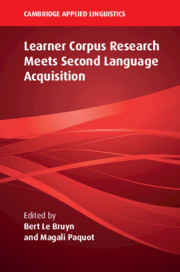Book contents
- Learner Corpus Research Meets Second Language Acquisition
- The Cambridge Applied Linguistics Series
- Learner Corpus Research Meets Second Language Acquisition
- Copyright page
- Contents
- Figures
- Tables
- Contributors
- Series Editors’ Preface
- Learner Corpus Research and Second Language Acquisition: an attempt at bridging the gap
- Article Use in Russian and Spanish Learner Writing at CEFR B1 and B2 Levels: Effects of Proficiency, Native Language, and Specificity
- L1 Influence vs. Universal Mechanisms: An SLA-Driven Corpus Study on Temporal Expression
- The Interplay between Universal Processes and Cross-Linguistic Influence in the Light of Learner Corpus Data: Examining Shared Features of Non-native Englishes
- Exploring Multi-Word Combinations as Measures of Linguistic Accuracy in Second Language Writing
- Using Syntactic Co-occurrences to Trace Phraseological Complexity Development in Learner Writing: Verb + Object Structures in LONGDALE
- Understanding the Long-Term Evolution of L2 Lexical Diversity: The Contribution of a Longitudinal Learner Corpus
- L2 Developmental Measures from a Dynamic Perspective
- Exploring Individual Variation in Learner Corpus Research: Methodological Suggestions
- Building an Oral and Written Learner Corpus of a School Programme: Methodological Issues
- Commentary: Have Learner Corpus Research and Second Language Acquisition Finally Met?
- Commentary: An SLA Perspective on Learner Corpus Research
- Index
- References
Learner Corpus Research and Second Language Acquisition: an attempt at bridging the gap
Published online by Cambridge University Press: 29 December 2020
- Learner Corpus Research Meets Second Language Acquisition
- The Cambridge Applied Linguistics Series
- Learner Corpus Research Meets Second Language Acquisition
- Copyright page
- Contents
- Figures
- Tables
- Contributors
- Series Editors’ Preface
- Learner Corpus Research and Second Language Acquisition: an attempt at bridging the gap
- Article Use in Russian and Spanish Learner Writing at CEFR B1 and B2 Levels: Effects of Proficiency, Native Language, and Specificity
- L1 Influence vs. Universal Mechanisms: An SLA-Driven Corpus Study on Temporal Expression
- The Interplay between Universal Processes and Cross-Linguistic Influence in the Light of Learner Corpus Data: Examining Shared Features of Non-native Englishes
- Exploring Multi-Word Combinations as Measures of Linguistic Accuracy in Second Language Writing
- Using Syntactic Co-occurrences to Trace Phraseological Complexity Development in Learner Writing: Verb + Object Structures in LONGDALE
- Understanding the Long-Term Evolution of L2 Lexical Diversity: The Contribution of a Longitudinal Learner Corpus
- L2 Developmental Measures from a Dynamic Perspective
- Exploring Individual Variation in Learner Corpus Research: Methodological Suggestions
- Building an Oral and Written Learner Corpus of a School Programme: Methodological Issues
- Commentary: Have Learner Corpus Research and Second Language Acquisition Finally Met?
- Commentary: An SLA Perspective on Learner Corpus Research
- Index
- References
Summary
Learner corpora are traditionally defined as ‘systematic collections of authentic, continuous and contextualized language use (spoken or written) by L2 learners stored in electronic format’ (Callies & Paquot 2015). With this characterization, it appears very clearly that learner corpus researchers have always been interested in exploring the output of the more open-ended types of contextualized production tasks assigned to L2 learners (e.g. Granger 2008; Tracy-Ventura & Myles 2015). The term ‘learners’ here refers to Foreign and/or Second Language learners rather than to learners acquiring their native language (L1).
- Type
- Chapter
- Information
- Publisher: Cambridge University PressPrint publication year: 2021



